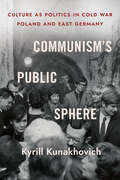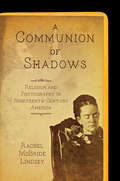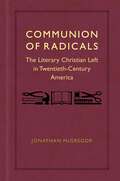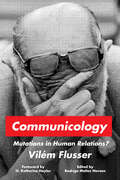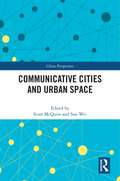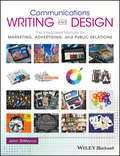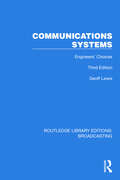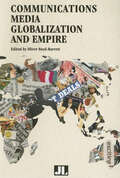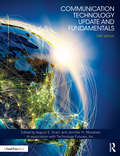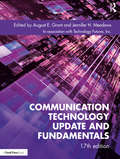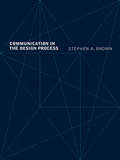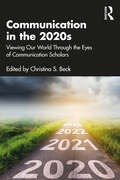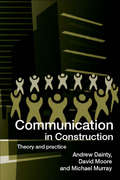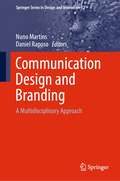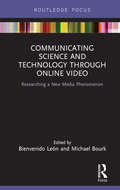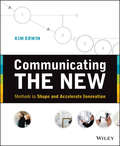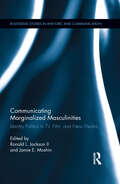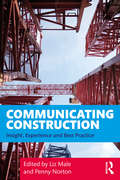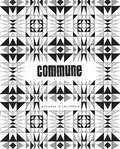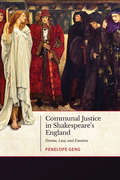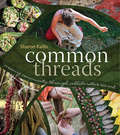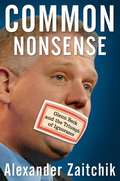- Table View
- List View
Communism's Public Sphere: Culture as Politics in Cold War Poland and East Germany
by Kyrill KunakhovichCommunism's Public Sphere explores the political role of cultural spaces in the Eastern Bloc. Under communist regimes that banned free speech, political discussions shifted to spaces of art: theaters, galleries, concert halls, and youth clubs. Kyrill Kunakhovich shows how these venues turned into sites of dialogue and contestation. While officials used them to spread the communist message, artists and audiences often flouted state policy and championed alternative visions. Cultural spaces therefore came to function as a public sphere, or a rare outlet for discussing public affairs.Focusing on Kraków in Poland and Leipzig in East Germany, Communism's Public Sphere sheds new light on state-society interactions in the Eastern Bloc. In place of the familiar trope of domination and resistance, it highlights unexpected symbioses like state-sponsored rock and roll, socialist consumerism, and sanctioned dissent. By examining nearly five decades of communist rule, from the Red Army's arrival in Poland in 1944 to German reunification in 1990, Kunakhovich argues that cultural spaces played a pivotal mediating role. They helped reform and stabilize East European communism but also gave cover to the protest movements that ultimately brought it down.
A Communion of Shadows: Religion and Photography in Nineteenth-Century America
by Rachel McBride LindseyWhen the revolutionary technology of photography erupted in American culture in 1839, it swiftly became, in the day's parlance, a "mania." This richly illustrated book positions vernacular photography at the center of the study of nineteenth-century American religious life. As an empirical tool, photography captured many of the signal scenes of American life, from the gold rush to the bloody battlefields of the Civil War. But photographs did not simply display neutral records of people, places, and things; rather, commonplace photographs became inscribed with spiritual meaning, disclosing, not merely signifying, a power that lay beyond.Rachel McBride Lindsey demonstrates that what people beheld when they looked at a photograph had as much to do with what lay outside the frame--theological expectations, for example--as with what the camera had recorded. Whether studio portraits tucked into Bibles, postmortem portraits with locks of hair attached, "spirit" photography, stereographs of the Holy Land, or magic lanterns used in biblical instruction, photographs were curated, beheld, displayed, and valued as physical artifacts that functioned both as relics and as icons of religious practice. Lindsey's interpretation of "vernacular" as an analytic introduces a way to consider anew the cultural, social, and material reach of religion.A multimedia collaboration with MAVCOR—Center for the Study of Material & Visual Cultures of Religion—at Yale University.
Communion of Radicals: The Literary Christian Left in Twentieth-Century America
by Jonathan McGregorPopular perceptions of American writers as either godless radicals or God-fearing reactionaries overlook a vital tradition of Christian leftist thought and creative work. In Communion of Radicals, Jonathan McGregor offers the first literary history of theologically conservative writers who embraced political radicalism, as their reverence for tradition impelled them to work for social justice. Challenging recent accounts that examine twentieth-century American literature against the backdrop of the rising Religious Right, Communion of Radicals uncovers a different literary lineage in which allegiance to religious tradition fostered dedication to a more just future.From the Gilded Age to the Great Depression to the civil rights movement, traditional faith empowered the rebellious writing of socialists, anarchists, and Catholic personalists such as Vida Scudder, Dorothy Day, Claude McKay, F. O. Matthiessen, and W. H. Auden. By recovering their strain of traditioned radicalism, McGregor shows how strong faith in the past can fuel the struggle for an equitable future. As Christian socialists, Scudder and Ralph Adams Cram envisioned their movement for beloved community as a modern version of medieval monasticism. Day and the Catholic Workers followed the fourteenth-century example of St. Francis when they lived and wrote among the disaffected souls on the Bowery during the Great Depression. Tennessee’s Fellowship of Southern Churchmen argued for a socialist and antiracist understanding of the notion of “the South and the Agrarian tradition” popularized by James McBride Dabbs, Walker Percy, and Wendell Berry. Agrarian roots flowered into creative expressions encompassing the queer and Black medievalist poetry of Auden and McKay, respectively; Matthiessen’s Catholic socialist interpretation of the American Renaissance; and the genteel anarchism of Percy’s southern comic novels. Imaginative writing enabled these Christian leftists to commune with the past and with each other, driving their radical efforts in the present.Communion of Radicals chronicles a literary Christian left that unites deeply traditional faith with radicalism, and offers a usable past that disrupts perceived alignments of religion and politics.
Communicology: Mutations in Human Relations? (Sensing Media: Aesthetics, Philosophy, and Cultures of Media)
by Vilém FlusserCommunicology is Vilém Flusser's first thesis on his concepts of technical images and technical imagination. In this foundational text he lays the groundwork for later work, offering a philosophical approach to communication as a phenomenon that permeates every aspect of human existence. Clearly organized around questions such as "What is Communication?," "What are Codes?," and "What is Technical Imagination?," the work touches on theater, photography, film, television, and more. Originally written in 1978, but only posthumously published in German, the book is one of the clearest statements of Flusser's theory of communication as involving a variably mediated relation between humans and the world. Although Flusser was writing in the 1970s, his work demonstrates a prescience that makes it of significant contemporary interest to scholars in visual culture, art history, media studies, and philosophy.
Communicative Cities and Urban Space (China Perspectives)
by Scott McQuireCities have long been recognized as key sites for fostering new communication practices. However, as contemporary cities experience major changes, how do diverse inhabitants encounter each other? How do cities remember? What is the role of the built environment in fostering sites for public communication in a digital era? Communicative Cities and Urban Space offers a critical analysis of contemporary changes in the relation between urban space and communication. This volume seeks to understand the situatedness of contemporary communication practices in diverse contexts of urban life, and to explore digitized urban space as a historically specific communicative environment. The essays in this book collectively propose that the concept of the ‘communicative city’ is a productive frame for rethinking the above questions in the context of 21st-century ‘media cities’. They challenge us to reconsider qualities such as openness, autonomy and diversity in contemporary urban communication practices, and to identify factors that might expand or constrict communicative possibilities. Students and scholars of communication studies and urban studies would benefit from this book.
Communications Writing and Design: The Integrated Manual for Marketing, Advertising, and Public Relations
by John DimarcoCommunications Writing and Design is an integrated, project-based introduction to effective writing and design across the persuasive domains of communication. Build a strong foundation of core writing and design skills using professionally-designed examples that illustrate and reinforce key principles Readers learn and analyze techniques by creating 15 projects in marketing, advertising, PR, and social media with the help of strategy suggestions, practical tips, and professional production techniques Written by an experienced professional and teacher, with a focus on the cross-disciplinary nature of contemporary communication work Learning is reinforced through a variety of pedagogical features: learning objectives, helpful mnemonics, real-life projects and applications, chapter references for further study, and end-of-chapter summaries and exercises A companion website with multimedia slides, exam questions, learning videos, and design guides provides additional learning tools for students and instructors
Communications Systems: Engineers' Choices (Routledge Library Editions: Broadcasting #18)
by Geoff LewisCommunications Systems (1999) examines various communications systems using satellites, and includes much information on coding and modulation systems such as MOBIC, digital SNG systems, mobile phones, MPEG, MPEG4 capabilities and Hypermedia, the Grand Alliance TV systems, MUSE and how it is used in Japan, the European and North American Digital Video Broadcasting Systems, MMDS and Digital Audio Broadcasting. It explores the rapid convergence occurring between satellite and terrestrial services. It provides a solid base of principles, including mathematics where necessary, to explain the developments which have taken place within these industries.
Communications Media, Globalization, and Empire
by Oliver Boyd-BarrettIn Communications Media, Globalization, and Empire, an international team of experts analyze and critique the political economy of media communications worldwide. Their analysis takes particular account of the sometimes conflicting pressures of globalization and "neo-imperialism." The first is commonly defined as the dismantling of barriers to trade and cultural exchange and responds significantly to lobbying of the world's largest corporations, including media corporations. The second concerns U.S. pursuit of national security interests as response to "terrorism," at one level and, at others, to intensifying competition among both nations and corporations for global natural resources.
Communication Technology Update and Fundamentals: 16th Edition
by August E. Grant Jennifer H. MeadowsFor three decades, Communication Technology Update and Fundamentals has set the standard as the single best resource for students and professionals looking to brush up on how communication technologies have developed, grown, and converged, as well as what’s in store for the future. The secret to the longevity is simple—every two years, the book is completely rewritten to ensure that it contains the latest developments in mass media, computers, consumer electronics, networking, and telephony. Plus, the book includes the Fundamentals: the first five chapters explain the communication technology ecosystem, the history, structure, and regulations. The chapters are written by experts who provide snapshots of the state of each individual field. Together, these updates provide a broad overview of these industries, as well as the role communication technologies play in our everyday lives. In addition to substantial updates to each chapter, the 16th edition includes: First-ever chapters on Virtual/Augmented Reality and eSports. Updated user data in every chapter. Overview of industry structure, including recent and proposed mergers and acquisitions Suggestions on how to get a job working with the technologies discussed. The companion website, www.tfi.com/ctu, offers updated information on the technologies covered in this text, as well as links to other resources.
Communication Technology Update and Fundamentals: 17th Edition
by August E. Grant Jennifer H. Meadows Technology Futures Inc.Communication Technology Update and Fundamentals, now in its 17th edition, has set the standard as the single best resource for students and professionals looking to brush up on how communication technologies have developed, grown, and converged, as well as what’s in store for the future. The book covers the fundamentals of communication technology in five chapters that explain the communication technology ecosystem, its history, theories, structure, and regulations. Each chapter is written by experts who each provide a snapshot of an individual field. The book also dives into the latest developments in electronic mass media, computers, consumer electronics, networking, and telephony. Together, these updates provide a broad overview of these industries and examine the role communication technologies play in our everyday lives. In addition to substantial updates to each chapter, the 17th edition includes the first-ever chapter on Artificial Intelligence; updated user data in every chapter; an overview of industry structure, including recent and proposed mergers and acquisitions; and sidebars exploring sustainability and relevance of each technology to Gen Z. Communication Technology Update and Fundamentals continues to be the industry-leading resource for both students and professionals seeking to understand how communication technologies have developed and where they are headed.
Communication in the Design Process
by Stephen A. BrownThe Design and Construction industry is in a state of attempted change. Improvement is a key word for employer, consultant and contractor. Real steps forward are slow, and most damning is the continuous repetition of the same mistakes. Communication in the Design Process considers the gap that can exist between client expectation and realisation in building projects. It focuses on the communication interface between the employer and the consultant design team, and specifically on the areas of function, finance, timescale and aesthetics. This book includes an extensive review of current thinking and guidance on this and other related subjects. New data is obtained from a survey using questionnaires and personal semi-structured interviews. Data is presented graphically, analysed and compared with practice as defined in current literature.
Communication in the 2020s: Viewing Our World Through the Eyes of Communication Scholars
by Christina S. BeckThis book provides an inside look at the discipline of Communication. In this collection of chapters, top scholars from a wide range of subfields discuss how they have experienced and how they study the crucial issues of our time. The 2020s opened with a series of events with massive implications for the ways we communicate, from the COVID-19 pandemic, a summer of protests for social justice, and climate change-related natural disasters, to one of the most contentious presidential elections in modern U.S. history. The chapters in this book provide snapshots of many of these issues as seen through the eyes of specialists in the major subfields of Communication, including interpersonal, organizational, strategic, environmental, religious, social justice, risk, sport, health, family, instructional, and political communication. Written in an informal style that blends personal narrative with accessible explanation of basic concepts, the book is ideal for introducing students to the range and practical applications of Communication discipline. This book comprises a valuable companion text for Introduction to Communication courses as well as a primary resource for Capstone and Introduction to Graduate Studies courses. Further, this collection provides meaningful insights for Communication scholars as we look ahead to the remainder of the 2020s and beyond.
Communication in the 2020s: Viewing Our World Through the Eyes of Communication Scholars
by Christina S. BeckThis book provides an inside look at the discipline of Communication. In this collection of chapters, top scholars from a wide range of subfields discuss how they have experienced and how they study the crucial issues of our time. The 2020s opened with a series of events with massive implications for the ways we communicate, from the COVID-19 pandemic, a summer of protests for social justice, and climate change-related natural disasters, to one of the most contentious presidential elections in modern U.S. history. The chapters in this book provide snapshots of many of these issues as seen through the eyes of specialists in the major subfields of Communication, including interpersonal, organizational, strategic, environmental, religious, social justice, risk, sport, health, family, instructional, and political communication. Written in an informal style that blends personal narrative with accessible explanation of basic concepts, the book is ideal for introducing students to the range and practical applications of Communication discipline. This book comprises a valuable companion text for Introduction to Communication courses as well as a primary resource for Capstone and Introduction to Graduate Studies courses. Further, this collection provides meaningful insights for Communication scholars as we look ahead to the remainder of the 2020s and beyond.
Communication in Construction: Theory and Practice
by Michael Murray David Moore Andrew DaintyCommunication within project-based environments presents special challenges. This is especially true within the construction industry, where interaction tends to be characterised by unfamiliar groups of people coming together for short periods before disbanding to work on other endeavours. This book examines communication at a number of levels ranging from interpersonal interactions between project participants to corporate communication between organizations. Several non-typical perspectives on the process of communication are introduced to encourage the reader to think about communication in a more innovative manner. The combination of differing perspectives illustrates the diversity of communication problems facing those working within project-based environments. Practical guidance is provided on possible solutions to communication problems, and a number of examples and case studies are presented.
Communication Design and Branding: A Multidisciplinary Approach (Springer Series in Design and Innovation #32)
by Nuno Martins Daniel RaposoThis book gathers new empirical findings fostering advances in the areas of communication design and branding, with a special emphasis of interdisciplinary approaches showing how to combine knowledge in those fields to improve businesses in a digital, global world. Gathering original, peer-reviewed contributions written by designers, computer scientists, marketer and product managers, this book provides both the communication and branding communities with a timely snapshot of current strategies and best-practices to improve different kinds of business through design. By highlighting current challenges, it is also intended to inspire and foster collaboration between different groups, in both university and industry.
Communicating through Graphic Design
by Kevin Gatta Claire Mowbray Golding Scott Menchin Luis Kerch Reba LibbyNIMAC-sourced textbook
Communicating Science and Technology Through Online Video: Researching a New Media Phenomenon (Routledge Focus on Communication Studies)
by Bienvenido León Michael BourkOnline video’s unique capacity to reach large audiences makes it a powerful tool to communicate science and technology to the general public. The outcome of the international research project "Videonline," this book provides a unique insight into the key elements of online science videos, such as narrative trends, production characteristics, and issues of scientific rigor. If offers various methodological approaches: a literature review, content analysis, and interviews and surveys of expert practitioners to provide information on how to maintain standards of rigour and technical quality in video production.
Communicating The New: Methods to Shape and Accelerate Innovation
by Kim Erwin"Communicating radical innovation is very different from discussing marginal change. Erwin's book provides a serious analysis of why, in this era of VUCA—Volatility, Uncertainty, Complexity and Ambiguity—we need to change our individual and organizational modes of communication. Erwin then provides a series of concrete, practical communication methodologies that we so need. Communicating the New is a book that needs to be offered in all of our best business-school classes." —Bruce Nussbaum, author of Creative Intelligence, former assistant managing editor for BusinessWeek, and Professor of Innovation & Design at Parsons The New School of Design "One of the main problems with executing innovation in organizations is also one of the least obvious. Communicating The New reminds us about an often neglected but crucial part in the innovation process. Applying the principles contained in this book will increase your chances for innovation success, both inside your company—overcoming organizational barriers, as well as outside—convincing your customers. This is an essential read for those who not only preach for improving the current state of things, but more important to those responsible for executing it." —Luis Arnal, Managing Partner, INSITUM "I was hooked instantly. The names of people that I should give this book to keep building with each new chapter. Communicating the New is thorough as well as thoughtful in providing an impressive compendium of models, framework, methods, and tools for navigating the 21st-century challenges of creating The New. Finally, a useful resource to navigate the complexity of creating The New." —Clement Mok, Designer, Entrepreneur, and Instigator "Anyone who has experienced the challenge of co-creating The New and engaging enterprise audiences will find useful ways to produce insight, influence, and impact." —Paul Siebert, Director of Research + Strategy, Steelcase
Communicating Marginalized Masculinities: Identity Politics in TV, Film, and New Media (Routledge Studies in Rhetoric and Communication #11)
by Ronald L. Jackson II Jamie E. MoshinFor years, research concerning masculinities has explored the way that men have dominated, exploited, and dismantled societies, asking how we might make sense of marginalized masculinities in the context of male privilege. This volume asks not only how terms such as men and masculinity are socially defined and culturally instantiated, but also how the media has constructed notions of masculinity that have kept minority masculinities on the margins. Essays explore marginalized masculinities as communicated through film, television, and new media, visiting representations and marginalized identity politics while also discussing the dangers and pitfalls of a media pedagogy that has taught audiences to ignore, sidestep, and stereotype marginalized group realities. While dominant portrayals of masculine versus feminine characters pervade numerous television and film examples, this collection examines heterosexual and queer, military and civilian, as well as Black, Japanese, Indian, White, and Latino masculinities, offering a variance in masculinities and confronting male privilege as represented on screen, appealing to a range of disciplines and a wide scope of readers.
Communicating Ice through Popular Art and Aesthetics (Palgrave Studies in Media and Environmental Communication)
by Anne Hemkendreis Anna-Sophie JürgensThis book brings together the perspectives of eminent and emerging scholars from fields as varied as science communication, art history, pop cultural studies, environmental studies, sciences studying ice and artists to explore the power of (popular) arts and aesthetics to communicate ice research and the urgency of environmental action. Examining the aesthetic strategies employed in images, (popular) visual fiction and narratives to convey meaning and awareness – and how they can be made fruitful for science communication – the project will generate new perspectives on how our collective environmental responsibility can be addressed and communicated across disciplines and divers audiences. In doing so, the volume will illuminate the cultural power of ice research and contribute to a better understanding of the cultural work that emerges from our ecological crisis.
Communicating Construction: Insight, Experience and Best Practice
by Liz Male and Penny NortonThis book is a wide-ranging exploration of PR and communication in the construction industry, with a strong emphasis on communications theory, strategy and technique. The editors begin with an introduction to the UK construction industry and its supply chains, as well as various elements of PR in relation to the construction process. Subsequent chapters provide a strategic overview, practical examples, success stories, case studies and personal perspectives on PR for different parts of the built environment and reputational issues in construction. Chapters include expert advice on communications for architecture, planning, building consultancy, building products and manufacturers, general and specialist contractors, construction technology, infrastructure and communicating sustainability in the built environment. The conclusion looks at the current and upcoming reputational priorities for communicators in construction, as well as the top ten priorities for implementing PR as a strategic management discipline in the industry. This book is essential reading for all construction PR teams, students studying both for built environment and PR/marketing degrees and CPD courses, and anyone working in the built environment sector who needs to consider PR and marketing as part of their role.
Commune: Designed in California
by Roman Alonso Steven JohanknechtA Town and Country magazine design pick, a monograph of the work of a California lifestyle and interior design firm, from the company&’s founders. Commune was established in Los Angeles in 2004 by four like-minded souls—Roman Alonso, Steven Johanknecht, Pamela Shamshiri, and Ramin Shamshiri—with a common mission: to enhance life through design and to blur the lines between disciplines, eras, and styles. California is for those who refuse to conform and who live for freedom of expression, indoor/outdoor living, and that golden sunshine glinting off the waves of the Pacific. Commune perfectly captures this spirit and embodies a new California style that freely mixes old and new in its layered, highly personal interiors that embrace color, pattern, and texture. This book is the first monograph of Commune&’s work, featuring its designs for private residences, hotels, commercial spaces, and restaurants, as well as the works they specially commission from virtually everyone in the artisan craftsman movement in California today. &“Heavyweight Champs—Our picks from this year&’s tempting crop of design books. Commune highlights work by the Los Angeles design group, known for its bohemian-chic approach to houses, hotels (such as LA&’s Ace), and home products.&” ―Town & Country Magazine
Communal Justice in Shakespeare’s England: Drama, Law, and Emotion
by Penelope GengThe sixteenth century was a turning point for both law and drama. Relentless professionalization of the common law set off a cascade of lawyerly self-fashioning – resulting in blunt attacks on lay judgment. English playwrights, including Shakespeare, resisted the forces of legal professionalization by casting legal expertise as a detriment to moral feeling. They celebrated the ability of individuals, guided by conscience and working alongside members of their community, to restore justice. Playwrights used the participatory nature of drama to deepen public understanding of and respect for communal justice. In plays such as King Lear and Macbeth, lay people accomplish the work of magistracy: conscience structures legal judgment, neighbourly care shapes the coroner’s inquest, and communal emotions give meaning to confession and repentance. An original and deeply sourced study of early modern literature and law, Communal Justice in Shakespeare’s England contributes to a growing body of scholarship devoted to the study of how drama creates and sustains community. Penelope Geng brings together a wealth of imaginative and documentary archives – including plays, sermons, conscience literature, Protestant hagiographies, legal manuals, and medieval and early modern chronicles – proving that literature never simply reacts to legal events but always actively invents legal questions, establishes legal expectations, and shapes legal norms.
Common Threads
by Sharon KallisDisposing of unwanted natural materials can be expensive and time-consuming, or it can present a tremendous opportunity for creating collaborative eco-art. Invasive-species control, green-waste management, urban gardening, and traditional crafts can all be brought together to strengthen community relationships and foster responsible land stewardship. Simple, easily taught, creative techniques applied with shared purpose become the modern-day equivalent of a barn raising or a quilting bee.Common Threads is a unique guide to engaging community members in communal handwork for the greater good. Sharon Kallis provides a wealth of ideas for: Working with unwanted natural materials, with an emphasis on green waste and invasive species Visualizing projects that celebrate the human element while crafting works of art or environmental remediation Creating opportunities for individuals to connect with nature in a unique, meditative, yet community-oriented wayCombining detailed, step-by-step instructions with tips for successful process and an overview of completed projects, Common Threads is a different kind of weaving book. This inspirational guide is designed to help artists and activists foster community, build empowerment, and develop a do-it-together attitude while planning and implementing works of collaborative eco-art.Sharon Kallis is a Vancouver artist who specializes in working with unwanted natural materials. Involving community in connecting traditional hand techniques with invasive species and garden waste, she creates site-specific installations that become ecological interventions. Her recent projects include The Urban Weaver Project, Aberthau: flax=food+fibre, and working closely with fiber artists, park ecologists, First Nations basket weavers, and others.
Common Nonsense: Glenn Beck and the Triumph of Ignorance
by Alexander ZaitchikWho is this guy and why are people listening? Forget Rush Limbaugh, Bill O'Reilly, and Sean Hannity--Glenn Beck is the right's new media darling and the unofficial leader of the conservative grassroots. Lampooned by the left and lionized by the far right, his bluster-and-tears brand of political commentary has commandeered attention on both sides of the aisle. Glenn Beck has emerged over the last decade as a unique and bizarre conservative icon for the new century. He fantasizes aloud about killing his political opponents and encourages his listeners to embrace a cynical paranoia that slides easily into a fantasyland filled with enemies that do not exist, and solutions that are incoherent, at best. Since the election of Barack Obama, Beck's bombastic, conspiratorial, and often viciously personal approach to political combat has made him one of the most controversial figures in the history of American broadcasting. In Common Nonsense, investigative reporter Alexander Zaitchik explores Beck's strange brew of ratings lust, boundless ego, conspiratorial hard-right politics, and gimmicky morning-radio entertainment chops. Separates the facts from the fiction, following Beck from his troubled childhood to his recent rise to the top of the conservative media heap. Zaitchik's recent three-part series in Salon caused so much buzz, Beck felt the need to attack it on his show. Based on Zaitchik's interviews with former Beck coworkers and review of countless Beck writings and television and radio shows. Examines Beck's high-profile obsessions (Acorn and Van Jones) as well as his lesser-known influences (obscure Mormon radicals like Cleon Skousen.) Zaitchik's writing has appeared in the New Republic, the Nation, Salon, Wired, the New York Times, and AlternetBeck, a perverse and high-impact media spectacle, has emerged as a leader in a conservative protest movement that raises troubling questions about the health of American democracy.
